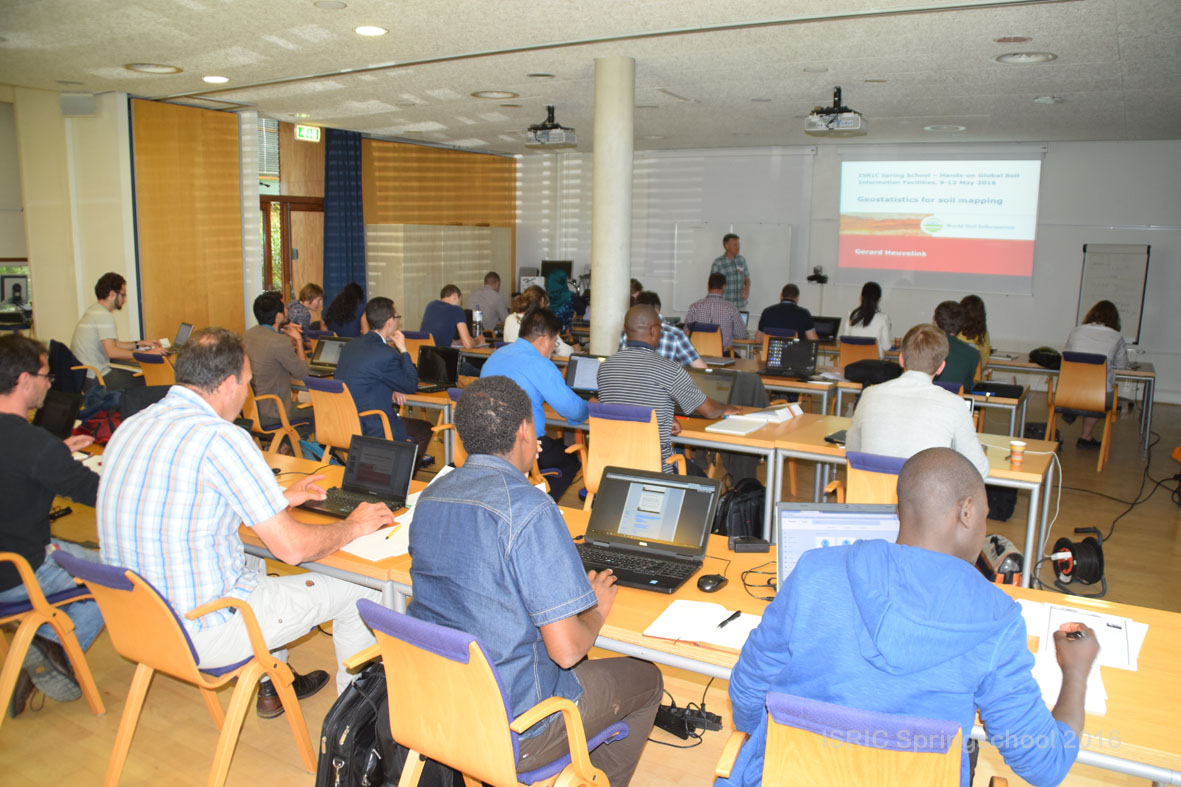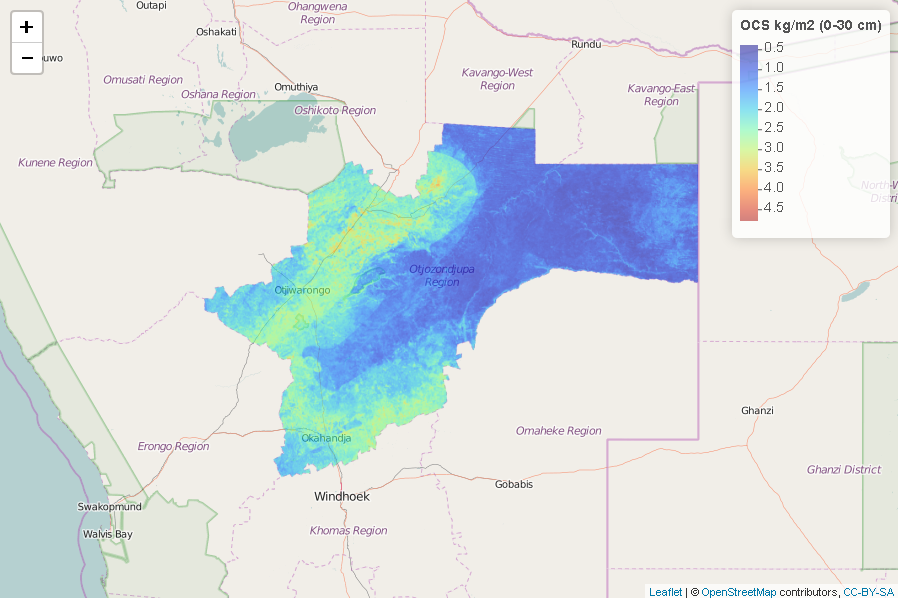Hands on Digital Soil Mapping 2018
Sections: Overview | Who is it for? | Software installation | Programme | Materials
 |
 |
Overview
This course introduces methods and software for management, analysis and mapping of soil variables within the R environment for statistical computing. The course alternates between lectures and computer practicals and covers a variety of subjects, such as geostatistics, linear regression and machine learning for soil mapping, quantification of uncertainty and soil map validation. The course aims at soil geographers and environmental scientists who want to learn more about the theory and practice of digital soil mapping. After this course participants will be able to apply the methods learnt to their own datasets. Lecturers are experienced pedometricians and soil data analysis specialists.
-
Gerard Heuvelink, course coordinator (geostatistics for soil mapping, uncertainty assessment)
-
Bas Kempen (introduction to R, data preparation, machine learning for soil mapping, validation of soil maps)
-
Eloi Ribeiro (soil databases)
-
Madlene Nussbaum, guest lecturer (machine learning and data mining)
-
Titia Mulder, guest lecturer (soil spectroscopy)
Who is it for?
This course is intended for soil and environmental professionals, researchers and students interested in producing soil maps and/or using local, regional and global soil datasets for digital soil mapping. Participants must have a basic level of statistics, geo-information science and soil/environmental science. Experience with computer programming in R is advantageous but not required. A number of recorded sessions from a previous Spring School can be accessed via the ISRIC YouTube channel at: http://youtube.com/c/ISRICorg.
Software installation
Please note that to participate in the DSM course you have to bring your own laptop computer, with R and RStudio software installed. Also, do not forget a power plug (travel) adapter if you need one. In the Netherlands the power sockets are of type C and F. We will not be able to provide you with these.
Software installation instructions can be found here, and the associated R code to test your installation here. Please read and follow these carefully to ensure you come fully prepared to the spring school.
Programme*
*Working programme subject to changes.
DAY 0 (OPTIONAL, Friday, 25 May 2018):
| Block | Topic | Room/ type | Lecturer |
| 9.00 – 17.30 |
Introduction to the statistical software R |
Lumen 1&2 guided self-study |
Bas Kempen |
DAY 1 (Monday, 28 May 2018):
| Time | Topic | Room/ type | Lecturer |
| 8.30 – 9.00 | Registration and Coffee | Hall Gaia building | |
| 9.00 – 9.45 |
Official opening of the ISRIC Spring School Group photo |
Gaia 1 | Rik van den Bosch (ISRIC director), Bas Kempen |
| 9.45 – 10.15 |
Course introduction and overview |
Lumen 1&2 | Gerard Heuvelink |
| 10.15 – 10.45 | Geostatistics for soil mapping |
Lumen 1&2 lecture |
Gerard Heuvelink |
| 10.45 – 11.15 | Coffee break | ||
| 11.15 – 12.30 | Geostatistics for soil mapping |
Lumen 1&2 lecture |
Gerard Heuvelink |
| 12.30 – 13.30 | Lunch | GAIA first floor | |
| 13.30 – 15.00 | Geostatistics for soil mapping |
Lumen 1&2 computer practical |
Gerard Heuvelink Titia Mulder |
| 15.00 – 15.30 | Coffee break | ||
| 15.30 – 17.30 | Geostatistics for soil mapping |
Lumen 1&2 computer practical |
Gerard Heuvelink Titia Mulder |
DAY 2 (Tuesday, 29 May 2018):
|
Block |
Topic |
Room/ type |
Lecturer |
|
9.00 – 10.00 |
Data preparation for DSM |
Lumen 1&2 lecture |
Bas Kempen |
| 10.00 – 10.30 | Data preparation for DSM |
Lumen 1&2 computer practical |
Bas Kempen Titia Mulder |
|
10.30 – 11.00 |
Coffee break |
||
|
11.00 – 12.30 |
Data preparation for DSM |
Lumen 1&2 computer practical |
Bas Kempen Titia Mulder |
|
12.30 – 13.30 |
Lunch |
||
|
13.30 – 15.00 |
Accessing the WOSIS database for soil profile data |
Lumen 1&2 lecture and exercise |
Eloi Ribeiro (Bas Kempen) |
|
15.00 – 15.30 |
Coffee break |
||
|
15.30 – 17.30 |
Remote and proximal sensing for natural resource inventories |
Lumen 1&2 lecture and exercise |
Titia Mulder (Bas Kempen) |
|
19.00 – 22.00 |
Dinner in town (Colours World Food restaurant) |
||
DAY 3 (Wednesday, 30 May 2018):
|
Block |
Topic |
Room/ type |
Lecturer |
|
9.00 – 10.30 |
Machine learning 1: Introduction to Random Forest Modelling |
Lumen 1&2 lecture |
Bas Kempen |
|
10.30 – 11.00 |
Coffee break |
||
|
11.00 – 12.30 |
Machine learning 1: Introduction to Random Forest Modelling |
Lumen 1&2 computer practical |
Bas Kempen Gerard Heuvelink |
|
12.30 – 13.30 |
Lunch |
||
|
13.30 – 15.00 |
Uncertainty quantification and propagation |
Lumen 1&2 lecture |
Gerard Heuvelink |
|
15:00 – 15:30 |
Coffee Break |
||
|
15.30 – 17:30 |
Uncertainty quantification and propagation |
Lumen 1&2 computer practical |
Gerard Heuvelink, Bas Kempen |
DAY 4 (Thursday, 31 May 2018):
|
Block |
Topic |
Room/ type |
Lecturer |
|
9.00 – 10.30 |
Machine learning 2: Understanding methods, model selection and interpretation |
Lumen 1&2 lecture |
Madlene Nussbaum |
|
10.30 – 11.00 |
Coffee break |
||
|
11.00 – 12.30 |
Machine learning 2: Understanding methods, model selection and interpretation |
Lumen 1&2 computer practical |
Madlene Nussbaum Bas Kempen |
|
12.30 – 13.30 |
Lunch |
||
|
13.30 – 15.00 |
Validation of digital soil maps |
Lumen 1&2 lecture |
Bas Kempen |
|
15.00 – 15.30 |
Coffee break |
||
|
15.30 – 17.30 |
Validation of digital soil maps |
Lumen 1&2 computer practical |
Bas Kempen Gerard Heuvelink |
DAY 5 (Friday, 1 June 2018):
|
Block |
Topic |
Room/ type |
Lecturer |
|
9.00 – 10.30 |
Visit to World Soil Museum and assignment |
WSM |
Stephan Mantel |
|
10.30 – 11.00 |
Coffee break |
||
|
11.00 – 12.30 |
Interactive Workshop opportunity for participants to present their work and receive feedback |
Lumen 1+2 |
Gerard Heuvelink |
|
12.30 – 13.30 |
Lunch |
||
|
13.30 – 14.30 |
Course evaluation, certificates |
Lumen 1+2 |
Gerard Heuvelink |
|
14.30 – 15.30 |
Measuring the value of the soil resource |
Lumen 1+2 guest lecture |
David Rossiter |
|
15.30 – 17.00 |
Closing words and ISRIC borrel (drinks and snacks) |
Lumen 1+2 |
Rik van den Bosch |